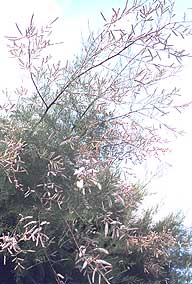Tamarisk - A Hardy Drought Tolerant Seaside Shrub
SOME TAMARISK VARIETIES
Tamarix africana Poir. Tamarix androssowii Tamarix arceuthoides Tamarix
boveana Tamarix duezenlii Tamarix elongata Tamarix gansuensis Tamarix
hampeana Tamarix indica
Tamarix juniperina
Tamarix sachuensis
Tamarix
tetrandra
PLANT SOCIETIES
TAMARISK (TAMARIX).
 Tamarisk
(Tamarix) is a hardy deciduous shrub with plumy sprays
of tiny white, pink or reddish flowers, slender branches and grey-green
foliage.
Tamarisk
(Tamarix) is a hardy deciduous shrub with plumy sprays
of tiny white, pink or reddish flowers, slender branches and grey-green
foliage.
Flowers appear on Tamarisks from late summer to early autumn. The pink flowers grow on new growth produced during the year.
Tamarisksucceed best in well-drained soils in full sun and do particularly well in coastal districts by the seaside as they are tolerant of salty winds and sandy soils. Tamarisks provide a welcome windbreak in breezy seaside and maritime gardens.
Tamarisk is also known Salt Cedar.
PRUNING TAMARISK
Tamarisks do well if they are hard pruned each April. This creates plenty of new growth and also prevents the shrub from getting too top heavy and leaving it susceptible to being blown over in high winds.
VARIETIES OF TAMARISK
Tamarisk is a genus of over sixty species of shrub - two are commonly grown in European gardens.
One of the loveliest is the Summer Tamarisk (Tamarix pentandra), which produces its pink flowers in July and August.
The Spring Tamarisk (T. tetrandra) flowers in May and may be cut back fairly hard immediately after flowering.
The French Tamarisk (T. gallica), pale pink, and English Tamarisk (T. anglica), nearly white, both flower in August and September and are often used as windbreaks near the sea.
There is also a rosy red form of Tamarisk.
PROPAGATING TAMARISK TREES
All tamarisks can be increased by cuttings in autumn.
Each Tamarisk flower produces thousands of tiny seeds.
If you want to grow a Tamarisk tree from seed be aware that Tamarisk seedlings need long periods of soil saturation to get them established
OTHER USEFUL ARTICLES ON GARDEN GROWER
How to grow Tamarisk - a Hardy wind and drought tolerant seaside shrub with delicate Pink blossom